วิเคราะห์พฤติกรรมในการจอดรถด้วยระบบจอดรถอัจฉริยะ โดยใช้เทคโนโลยีอินเทอร์เน็ตทุกสรรพสิ่ง
คำสำคัญ:
อินเทอร์เน็ตทุกสรรพสิ่ง, เทคโนโลยีวิทยุเครือข่ายบริเวณกว้างที่ใช้พลังงานต่ำ, ระบบจอดรถโดยใช้เทคโนโลยีอินเทอร์เน็ตทุกสรรพสิ่งบทคัดย่อ
งานวิจัยนี้ได้พัฒนาต้นแบบนวัตกรรมของระบบจอดรถอัจฉริยะโดยใช้เทคโนโลยีอินเทอร์เน็ตทุกสรรพสิ่ง (Internet of Things: IoT) พร้อมมาตรฐานเทคโนโลยีวิทยุเครือข่ายบริเวณกว้างที่ใช้พลังงานต่ำ (Narrow Band Internet of Things: NB-IoT) ในการตรวจพบสถานะจุดจอดรถว่ามีสถานะว่างหรือไม่ใช้งาน และส่งไปยังฐานข้อมูลบนเทคโนโลยีคลาวด์ (Cloud Technology) และแสดงสถานะการจอดแบบเรียลไทม์ผ่านแอปพลิเคชันมือถือ ระบบนี้ช่วยให้ผู้ใช้ได้ทราบตำแหน่งจุดจอดรถที่ว่างแบบเรียลไทม์โดยได้มีการติดตั้งอุปกรณ์ 200 จุดในพื้นที่ศึกษาในพื้นที่จังหวัดขอนแก่น เช่น ในมหาวิทยาลัยขอนแก่น และหน่วยงานราชการในเขตเทศบาลนครขอนแก่น ระบบจอดรถอัจฉริยะนี้ช่วยทำให้เกิดความเข้าใจในพฤติกรรมการใช้พื้นที่จอดรถ ซึ่งข้อมูลนี้เป็นประโยชน์ในการจัดสรรพื้นที่ได้อย่างมีประสิทธิภาพ สร้างรูปแบบการบริการการจอดรถในวิธีการใหม่ ๆ และการวางแผนการใช้พื้นที่เพื่อสร้างความเจริญเติบโตทางเศรษฐกิจและช่วยลดผลกระทบทางสิ่งแวดล้อม
เอกสารอ้างอิง
Ajeng, Carolina, and Tae-Hyoung Gim. “Analyzing On-Street Parking Duration and Demand in a Metropolitan City of a Developing Country: A Case Study of Yogyakarta City, Indonesia.” Sustainability, vol.10, no.3, p. 591, Feb. 2018, https://doi.org/10.3390/su10030591.
Al-Turjman, Fadi, and Arman Malekloo. “Smart Parking in IoT-Enabled Cities: A Survey.” Sustainable Cities and Society, vol.49, p. 101608, 2019, https://doi.org/10.1016/j.scs.2019.101608.
Baros, Jan, et al. “Development of Application for Control of SMART Parking Lot.” IFAC-PapersOnLine, vol.52, no.27, pp. 19–26, 2019, https://doi.org/10.1016/j.ifacol.2019.12.726.
Barter, Paul A. “Parking Requirements in Some Major Asian Cities.” Transportation Research Record: Journal of the Transportation Research Board, vol.2245, no.1, pp. 79–86, 2011, https://doi.org/10.3141/2245-10.
Chen, Na, et al. “Parking Survey Made Efficient in Intelligent Parking Systems.” Procedia Engineering, vol.137, pp. 487–95, Jan. 2016, https://doi.org/10.1016/j. proeng.2016.01.284.
Faheem, et al. “A Survey of Intelligent Car Parking System.” Journal of Applied Research and Technology, vol.11, no.5, pp. 714–26, Oct. 2013, https://doi.org/10.1016/S1665-6423(13)71580-3.
Kotb, Amir O., et al. Smart Parking Guidance, Monitoring and Reservations: A Review. University of Liverpool, 2017, http://dx.doi.org/10.1109/mits.2017.2666586.
Lan, Kun-Chan, and Wen-Yuah Shih. “An Intelligent Driver Location System for Smart Parking.” Expert Systems with Applications, vol.41, no.5, pp. 2443–56, Apr. 2014, https://doi. org/10.1016/j.eswa.2013.09.044.
Li, Bo, et al. “MADM-Based Smart Parking Guidance Algorithm.” PLOS ONE, vol.12, no.12, p. e0188283, Dec. 2017, https://doi.org/10.1371/journal.pone.0188283.
Lynn, Theo, and Charles Wood. “Smart Streets as a Cyber-Physical Social Platform: A Conceptual Framework.” Sensors, vol.23, no.3, p. 1399, Jan. 2023, https://doi.org/10.3390/s23031399.
Parmar, Janak, et al. “Study on Demand and Characteristics of Parking System in Urban Areas: A Review.” Journal of Traffic and Transportation Engineering (English Edition), vol.7, no.1, pp. 111–24, 2020, https://doi. org/10.1016/j.jtte.2019.09.003.
Perković, T., et al. “Smart Parking Sensors: State of the Art and Performance Evaluation.” Journal of Cleaner Production, vol.262, p. 121181, 2020, https://doi .org/10.1016/j.jclepro.2020.121181.
Rupani, Sahil, and Nishant Doshi. “A Review of Smart Parking Using Internet of Things (IoT).” Procedia Computer Science, vol.160, pp. 706–11, Jan 2019, https://doi.org/10.1016/j.procs.2019.11.023.
Safi, Qamas Gul Khan, et al. “SVPS: Cloud-Based Smart Vehicle Parking System over Ubiquitous VANETs.” Computer Networks and ISDN Systems, vol.138, pp. 18–30, June 2018, https://doi.org/10.1016/j.comnet.2018.03.034.
Sai Sree, Gurrala, et al. “An Analysis of Intelligent Parking System Using Artificial Intelligence for IoT Applications.” Advances in Transdisciplinary Engineering, edited by Kvs Ramachandra Murthy et al., IOS Press, 2023, https://doi.org/ 10.3233/ATDE221303.
Thanh Truong, Thi My, and An Minh Ngoc. “Parking Behavior and the Possible Impacts on Travel Alternatives in Motorcycle-Dominated Cities.” Transportation Research Procedia, vol.48, pp. 3469–85, 2020, https:// doi.org/10.1016/j.trpro.2020.08.105.
Truong, Thi My Thanh. Impacts of Digitalisation on Travel Behaviour in Hanoi City Centre. 2021, p. 040004, https://doi.org/10.1063/5.0070725.
Vlahogianni, Eleni I., et al. “A Real-Time Parking Prediction System for Smart Cities.” Journal of Intelligent Transportation Systems, vol.20, no.2, pp. 192–204, Jan. 2016, https://doi. org/10.1080/15472450.2015.1037955.
Zhang, Junyi, and Shenjing He. “Smart Technologies and Urban Life: A Behavioral and Social Perspective.” Sustainable Cities and Society, vol.63, p. 102460, 2020, https://doi.org/10.1016/ j.scs.2020.102460.
ดาวน์โหลด
เผยแพร่แล้ว
รูปแบบการอ้างอิง
ฉบับ
ประเภทบทความ
สัญญาอนุญาต
ลิขสิทธิ์ (c) 2023 คณะเทคโนโลยีอุตสาหกรรม มหาวิทยาลัยราชภัฎสวนสุนันทา

อนุญาตภายใต้เงื่อนไข Creative Commons Attribution-NonCommercial-NoDerivatives 4.0 International License.
บทความที่ได้รับการตีพิมพ์เป็นลิขสิทธิ์ของคณะวิศวกรรมศาสตร์และเทคโนโลยีอุตสาหกรรม มหาวิทยาลัยราชภัฎสวนสุนันทา
ข้อความที่ปรากฏในบทความแต่ละเรื่องในวารสารวิชาการเล่มนี้เป็นความคิดเห็นส่วนตัวของผู้เขียนแต่ละท่านไม่เกี่ยวข้องกับมหาวิทยาลัยราชภัฎสวนสุนันทา และคณาจารย์ท่านอื่นๆในมหาวิทยาลัยฯ แต่อย่างใด ความรับผิดชอบองค์ประกอบทั้งหมดของบทความแต่ละเรื่องเป็นของผู้เขียนแต่ละท่าน หากมีความผิดพลาดใดๆ ผู้เขียนแต่ละท่านจะรับผิดชอบบทความของตนเองแต่ผู้เดียว








